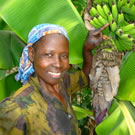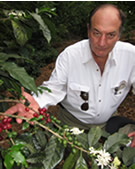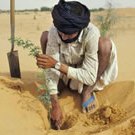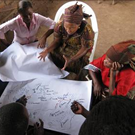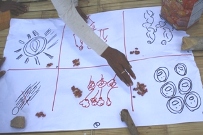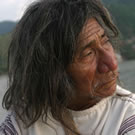Water & Climate Change News
| 1. Families in Kenyan Village Have 4% of the Water as do Canadian Families | |
 |
Maggie Muthui of Kenya, and Erin Watson of Canada—developed this project over the course of four months to protect the village spring and distribute fresh water into the Kenyan village of Lita. |
|
Due to a lack of adequate water resources, the community of Lita suffers from many problems including a lack of food security, poor hygiene, and increased risk of disease.
500 households require a minimum of 80 liters of water per day for drinking, washing, and cooking. That’s 13.3 L per person per day as compared to the 329 L currently used by the average Canadian! The project will help protect the one remaining natural spring in Lita allowing families access a safe source of drinking water.
|
|
| 2. 36% Water Shortage in Mexico City: Rainwater Harvesting Solution | |
 |
36% of families in Mexico City do not have adequate access to water for bathing, washing dishes or clothes, or flushing toilets.
CSDi Partner David Vargas began the process of developing a project to help 550 families in Mexico City gain access to water through a rooftop rainwater harvesting project. |
|
Rainwater harvesting systems provide families with about 50% of their water demand. David’s program trains & pays local plumbers to install the systems. They buy all materials locally to support the local economy & ensure that families can maintain systems easily on their own. The systems provide families access to clean water while enhancing their economic situation & quality of life.
|
|
 |
Chris Enns & Catalina Gheorghe are doing a community-based adaptation to climate change project in Wagete village, Tanzania, impacting 4,000 villagers. Their project is a ‘mainstreamed’ project—they are incorporating adaptation to climate change activities into a traditional rural development project.
|
|
For the traditional development portion of their project they have a healthcare & education component— and for adaptation—a water conservation and management program. Detailed project outline & great photos at link.
They’ve been determining their risks and vulnerabilities to climate change by combining scientific data with local community knowledge. Chris and the community developed a list of local resources, hazard maps, a seasonal calendar & a historical timeline.
Drought and Flood. The facilitator asked group members to rank the vulnerability of each identified resource from each of the identified hazard. Drought and flood ranked as the highest hazards to livelihood resources. See the livelihood/hazard results matrix link above.
|
|
 |
Matt produced this excellent short documentary addressing the impacts of climate change on water resources in Mauritius, an island in the Western Indian Ocean, and how people are beginning to respond.
|
|
Too much rain in May and drought conditions in November negatively affect farmers with both extremes. Rainfall is down 10 % but the intensity has increased. 50% of water stored in reservoirs is lost to leaks. The film shows us how having supplies of water resources and managing them are 2 different things.
|
|
|
Prem Goolaup, of the island state of Mauritius in the Indian Ocean, has been developing a community based adaptation project for the past eight months. At times the farmers suffer from drought—at other times flooding.The adaptation components of his project include a Water Management Program.
|
|
|
He’s using a participatory mapping technique to not only learn more about the specific challenges the farmers face, but by including farmers in the research and drawing of the map, they are better understanding their current challenges and also developing a sense of ownership for the project.
What is a prioritization of the community’s greatest hazards they face?
Farmer adaptation strategies include:
|
|
| 6. 300 Hands-On Field Activities for Community Based Adaptation Projects: Water is the Underlying Theme | |
 |
I am announcing an updated compilation of Community Based Adaptation Field Activities—complete with links to source materials and technical information.
This collection of 300 CBA field activities began as a resource for our CBA online students.
|
|
However, as it grew, we decided that it was important to make it more broadly available to CBA development practitioners.
Water is a key component in each of the following categories.
Here are how the activities are organized: 1. Agriculture and water.
2. Small island developing states. 3. Emergency preparedness and disaster risk reduction. 4. Energy. 5. Livelihood. 6. Health & sanitation. 7. CBA project design. 8. CBA participatory inclusion. 9. Long-term investments. 10. General resources. |
|
|
7. Help Scale Up Project Successes: Help Us Increase Impact to 200,000 Beneficiaries by December 31.
|
|
 |
Help us to scale-up these impacted-oriented courses and their resulting projects. In the courses’ first 21 months people from 500 organizations in 153 countries have developed and are developing projects impacting 400,000 people. Help us scale up the reach of our courses so that a much greater number of students can begin projects and increase this impact to 500,000 people by year’s end.
|
|
HOW: NETWORKING.
Please spread the word about our courses to your friends/colleagues through your blog, your newsletter or your Facebook page—or by ‘liking’ & commenting on this post on our Facebook Page. Consider making a scholarship donation for field staff who can’t afford course fees.
To learn about other student projects in real time, please visit our Facebook Page; or visit the CSDi Development Community to see their regular postings—and join 600 colleagues in sharing resources & collaborating online. Visit Online Learning to see a full listing of Winter Quarter Community Based Adaptation courses that begin in January 2012.
|
|
